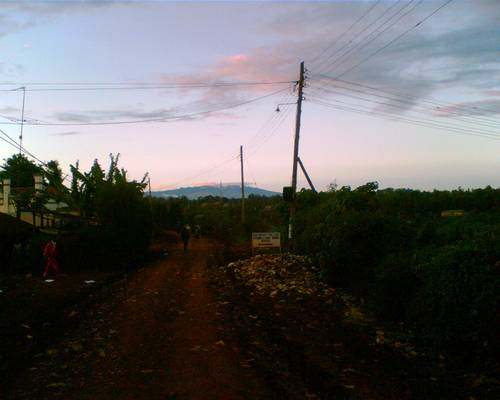
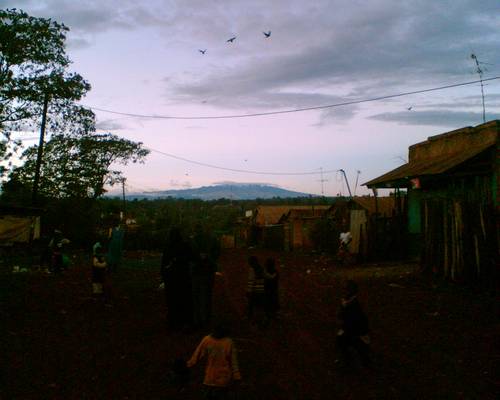
Mt. Kenya (Kirinyaga) as viewed from “Dallas”, Embu.
Such a splendid view redeems (for) all the matope (mud) infested places in rural areas.


Mt. Kenya (Kirinyaga) as viewed from “Dallas”, Embu.
Such a splendid view redeems (for) all the matope (mud) infested places in rural areas.
Climate Change! It starts with us. No one ever forced us to buy/consume products* which are not eco-effective.
I am 100% d’accord with Oscar’s wonderful appeal to the delegates to produce some useful output instead of just “churning out more re-cycled reports”.
And then I start thinking about my very own expectations on the Climate Change Conference, the desired output, how much I would love to see experts formulating a real draft that would actually promote a more eco-effective product design and create an awareness for sustainability. A draft that could be implemented 1:1 on national levels without much further ado, also because it’s impact doesn’t stop on national boundaries. Something that is powerful enough to change the minds of those who prefer financial profit to environmental protection. And, obviously, something that every nation on this planet has to sign (eh, you too, USA!).
(*products = everything we have produced during the last 200 years. this includes the exploration of energy resources, factories, etc. which all contribute to the change of climate during that period.)
—
“If you want to know about the state of a place, check the backyard”, my boss told me this morning. “If you go to someone’s place and you want to know how clean it is, go to his bathroom. If you want to know about a restaurant, check the kitchen. This is why our backyard is clean.”
No wonder we sometimes call him mwalimu mkuu.

So some people were cleaning the workshop room which had been inherited from a previous state office – including all the crap and many useful things like nice office furniture from the 1960s/70s (perfect quality compared to the furniture which has been donated some time ago) came to the daylight. So much potential. My boss knew about this and told my colleagues to clean the place.
“You know I went to Forodha Towers in Nbo earlier this year – and made a snap shot of the backyard”, I told him. “I even put it on the internet.”
“Yes”, he replied, “in fact you should take a snap shot of our backyard and also put it there to show that we have nothing to hide.”
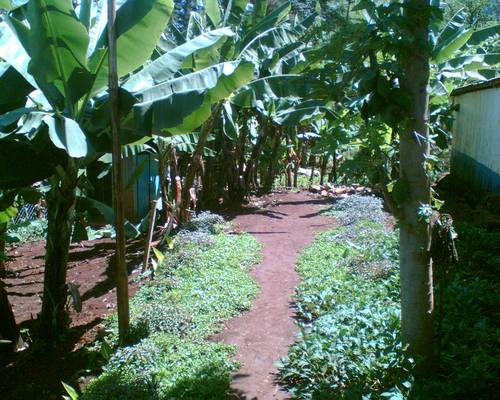
Bananas, a ventilated pit latrine and pawpaws in our backyard. Karibu(ni)!
I read this story on GIS services to be installed at the Police in Kenya (for crime tracking) and a conference/workshop that had been in held in Nairobi on this matter, organized by ESRI (GIS software company).
Someone was quoted as having said that all GIS services // data should be organized in a central database and made available to anyone who needs to work with it (free & against charges).
Earlier this week I started working on some GIS maps for Kenya and combining a pysical map of a water catchment area with local attributes (poverty figures, etc.). I do agree that such maps should be stored in a single database so that all organisations and instutions in Kenya are using the same maps and shouldn’t start coming up with their own homebrewn versions. There’s no need for double work.
Ppl in Kenya know this and I am not the first person who had this idea. Yani, between having the idea and actually maintaining such a database is a huge gap. Does anyone know where to obtain maps & figures for Kenya?
So far I have collected data from these online resources:
Depha.org – Data Exchange Platform For The Horn Of Africa (good!!)
GeoCommunnity (Kenya national data )
ILRI Kenya – International Livestock Research Institute (awesome collection)
…and another resource I just can’t remember right now…
While googling for free gis data, I came across a workshop that had been held recently in Nbo and which showed that the top officials of the Ministry/Authority I am currently working for had been officially informed on the proper use of GIS systems. So….these folks know about the advantages and received proper training I wish I could have enjoyed as well. It seems that GISystems have been introduced many times in Kenya and still there is no central database for such data. Or is there?
Which brings me to another thing I wanted to mention: Like in any other country, there are the ordinary wanainchi on the streets and some very smart and intellectual people that always impress me with their exact analysis and understanding of certain situations. Social, political, environmental – you name it, they can explain it – and even under a historical context. Koigi isn’t the only frustrated intellectual out there, there are many others who qualify to substitute even those typical 1970s university dons (with their hatred and aggregated mzungu aggressions) and help build this country.
Well, you see, the reason I mention this normality which otherwise would imply some sort of contemptuousness for the rest of the nation is that our former landlord G.Kirima – to name at least someone – used to be Deputy Major of Nairobi in 1974 ALTHOUGH he doesn’t even know how to write his name. Now that’s 32 years ago. And Kenya has changed kabisa. The nation of drunkards, as some like to call it, also knows that a beer never goes without a story. The intellectual wit, this desire to get an understanding for the overall context and mix everything to a big picture while at the same time keeping this timeline and analysing political circumstances with social developments – I think that’s one of Kenya’s biggest potentials.
Happy 144mio Kshs. Heroes Day!
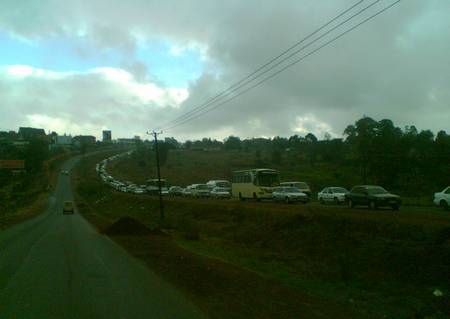
traffic jam @ 7 a.m., Thika Road (up to JKU!)
I wonder WHEN smart ppl will construct parking lots in Githurai and offer bus services from there to the City Centre (and likewise at other outskirts around Nbo) to ease up traffic congestion every morning….
Compared to the previous three weeks, it didn’t rain today and so we went for a mushroom foray in the nearby woods. I had never done this before – despite of living here in this remote, upcountry village since 5 years – and was fortunate enough to be guided by an experienced person who told me what to look for and where those mushroom spots could possibly be.
We found a lot of rubbish (why are ppl misusing the forests as landfills anyways?) and managed to collect a bucket full of yellow boletus and bay boletus. Unfortunately, I didn’t take my camera with me – the forest has lots of interesting sights and small details that need to be captured on camera one day. For instance, I’ve never seen so many dor beetles on one spot. Interesting!
Btw, is there anything like a guided tour on “surviving in the savannah” available in Kenya? Something for the city people, the urban commuters who haven’t yet taken their time to enjoy the beauty of nature? I don’t think so, ama? Do I smell a good business idea here? Hmm… :-)
Unfortunately, the downside of moving around in the woods are various insects that find their way through your long-sleeved shirt and pullover and end up crawling your back even long time after you’ve succesfully returned home. Arachnoides such as ticks – these little vampires that want to suck your blood – and there are stories of men that found such insects in places where you really wouldn’t want them to be…Since I am very ticklish, I managed to find some of them on my body right before they start their evil job…
Earlier this week, Google released a new version of its earth viewer programme Google Earth – a stable BETA 4 which I just had to download and try out.
As far as I can tell, the new BETA looks promising, making navigation much easier and faster (!) – and of course with a new release, they also implemented some “new” maps/satellite images:
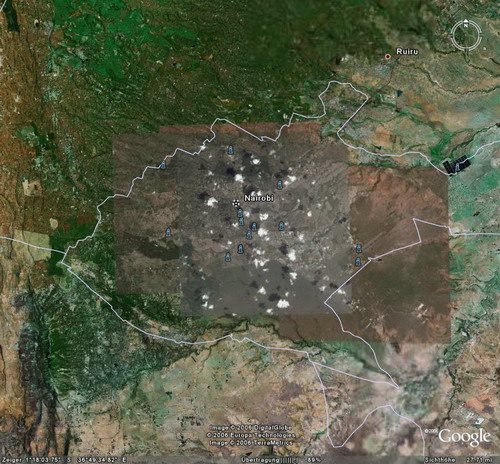
For downtown Nairobi, the guys running the image database added a CLOUDY satellite image – which is still better than what we had some time ago.
Now let’s have a look at Nairobi State House….
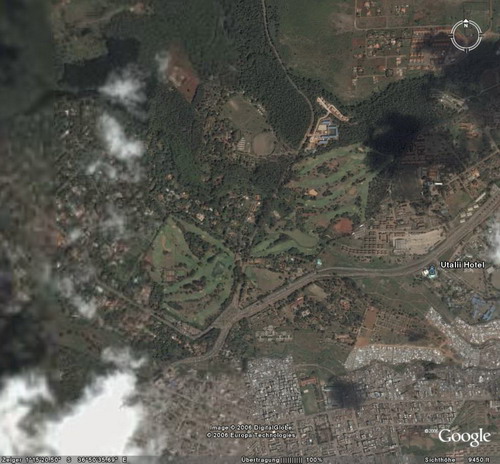
…sorry, this one of course :-)
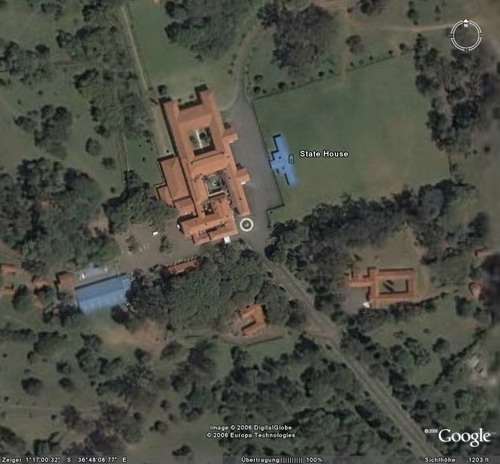
Google Earth is also perfect for tracking down the various swimming pools all over Nairobi. Something that might come in handy while in Nairobi, in search for an open swimming pool. After all, not all pools are private (which of course reminds me of Mbuzimoja & me trying to find an open pool in NBO as late as 8pm – the only place open till 9pm is….THE GRAND REGENCY HOTEL, which charges Kshs. 1.000 /= pp….aterere…).
Part 2 of Saturday saw us doing it the Nairobi way by switching from the dirt of Waruku to the beautiful view(s) behind Karen – in particular the area next to that KBC transmitter station somewhere on the way to Ngong.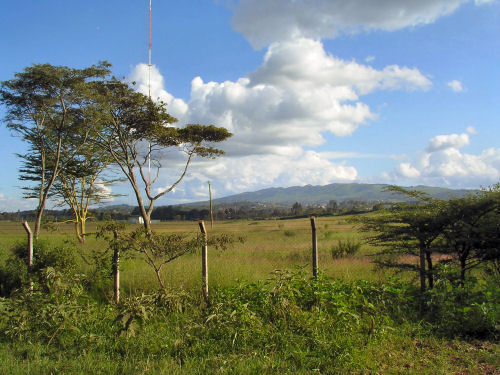
That’s for you, dear Oscar & Zora! :-)
It was already late in the afternoon and we were hungry so our stomaches forced us to cancel any further Kitengela-related plans but instead proposed an improvised and spontaneous picnic at the road-side.
Ok, this is Kenya, there’s no picnic possiboooool as most plots belong to someone, so we ended up driving up to Ngong where we received the message by telephone that some strange Telekom Kenya guys had come to our place in Kigwaru during the day (which is in the north-west of Nairobi) to erect a telephone post (good) and in the process of that hacked the 2 month old water pipe into pieces (bad). Instead of returning home, though, we continued our crazy idea of enjoying our food somewhere in nature and consequently had us driving up Ngong Hills as late as 5.45 pm to reach the gates on top already closed (we met the rangers half way through and continued anyways).

The picnic included some roasted maize from the the road side as well as the unevitaboooool Lucozade Boost which btw still tastes the same as it did “back in those days”.
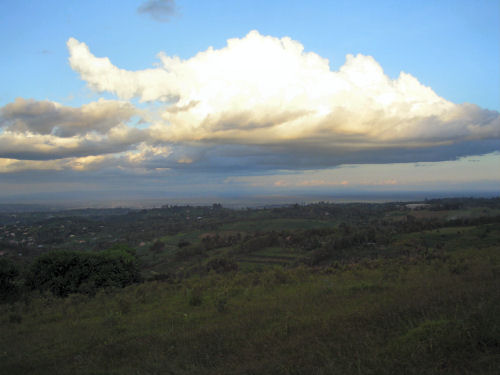
I tend to think that being able to do such excursions (time, money, transport, etc.) is pure luxury that needs to be enjoyed whenever possible.

I could just sit there all day long and enjoy the beauty of the view…..

Inspired by Banzungu Buck‘s comment on my previous entry (on this ICRAF publication), I would like to ask my readers to please comment on the following question: What’s your local name for these Luffa vines?
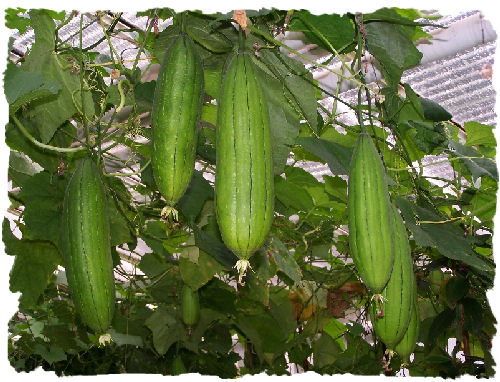
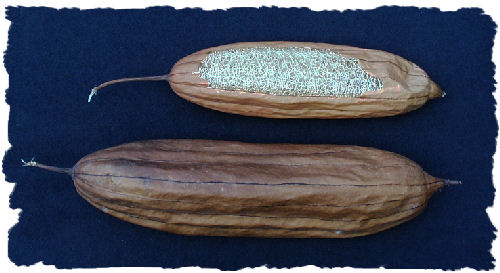
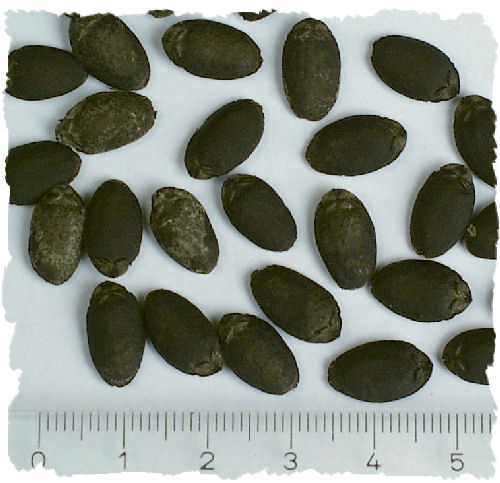
(all pictures courtesy of Karlheinz Knoch – thx!)
I bought a few, still fresh (~unprepared) luffa sponges in Machakos, Kenya one day and planted the contained seeds in my shamba next to a Hibiscus plant. The Luffa grew fast and produced about 7 really fat sponges/cucumbers, which I later on dried up and bathed in OMO (I understand ppl use JIK to bleach them). So, although these vines are grown in Kenya, I was trying hard to get a local name for it. Someone told me what they are called in Kikamba, but I forgot… anyone? THX!